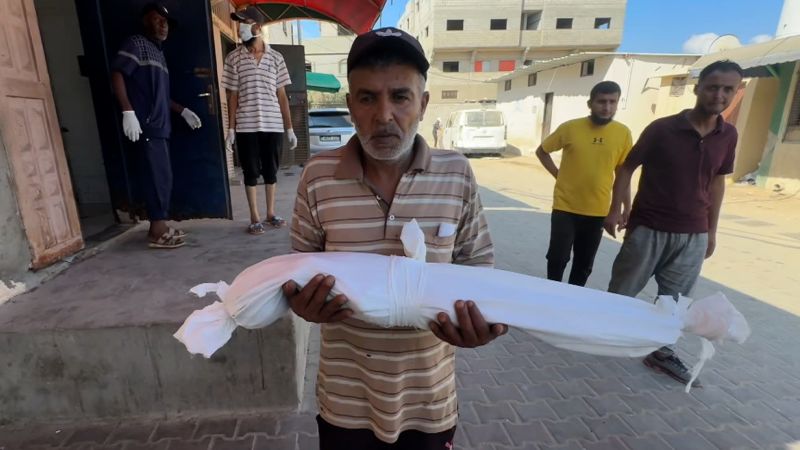The face of seven-year-old Nadia Al-Bakri, captured in a photograph taken three weeks before her death, tells Gaza’s story more clearly than any diplomatic communiqué. Hollow-cheeked with eyes too large for her face, she died yesterday at a makeshift clinic in northern Gaza, becoming the fifth child this week to succumb to malnutrition-related complications.
“We had nothing to give her but water with a pinch of salt for three days,” her father Mahmoud told me via a patchy WhatsApp connection from a relative’s apartment where eighteen family members now share two rooms. “The aid trucks stopped coming to our area weeks ago.”
The World Food Programme now estimates that 98% of Gaza’s population faces acute food insecurity, with children under ten showing the most severe symptoms of what medical professionals are calling a full-blown nutrition emergency. According to UNICEF data released Tuesday, cases of severe acute malnutrition have increased 700% since hostilities escalated in late 2023.
I’ve spent fourteen years covering conflicts from Syria to South Sudan, but veteran aid workers tell me Gaza represents something unprecedented – a nutrition crisis occurring in real-time under constant international observation, yet with minimal effective intervention.
“This is not a supply problem, it’s an access catastrophe,” explains Dr. Sara Mehta, nutrition coordinator with Médecins Sans Frontières. “The food exists, sometimes just kilometers away, but comprehensive distribution networks have collapsed under bombardment, checkpoint restrictions, and the complete breakdown of infrastructure.”
The Al-Bakri family’s neighborhood in Beit Lahia once housed 40,000 residents. Drone footage obtained from local journalists shows approximately 70% of structures severely damaged or destroyed. The area’s last functioning water treatment facility ceased operations in April after fuel supplies were exhausted.
Despite multiple UN Security Council resolutions calling for unimpeded humanitarian access, daily aid deliveries have fallen to less than 25% of pre-October levels. The Coordination of Government Activities in the Territories (COGAT), the Israeli agency overseeing aid entry, maintains that security concerns and diversion of supplies by militants necessitate the current inspection regime.
Palestinian officials counter that inspection procedures have become increasingly complex, with trucks often waiting 8-10 days before receiving clearance to enter Gaza. When supplies do arrive, distribution faces almost insurmountable challenges.
“We’re talking about families drinking brackish water, consuming less than 700 calories daily, in temperatures exceeding 100°F,” says Fatima Abdel-Rahman, a Gaza City-based coordinator with the Palestinian Medical Relief Society. “Children are particularly vulnerable because their bodies have no reserves left.”
Two weeks ago, I interviewed parents at an emergency feeding center in Khan Younis who described feeding their children boiled grass and animal feed. One mother showed me a notebook where she tracked her four children’s weight loss – her nine-year-old son had lost 40% of his body mass since January.
The International Criminal Court’s chief prosecutor, following a four-day assessment visit to bordering areas, announced yesterday an expansion of the ongoing investigation to include allegations of using starvation as a method of warfare – a war crime under the Rome Statute.
Meanwhile, diplomatic efforts continue without apparent breakthrough. A Qatari-Egyptian proposed ceasefire framework includes provisions for dramatically increased aid delivery, but implementation remains stalled over security arrangements and prisoner exchange terms.
For families like Nadia’s, these diplomatic maneuvers exist in a parallel universe. “My daughter didn’t understand politics or war,” Mahmoud Al-Bakri said. “She just kept asking when she could eat again.”
Health workers have documented at least 320 cases of children with severe acute malnutrition currently requiring immediate intervention. The actual number is likely much higher, as many families cannot reach medical facilities.
Dr. Mehta notes that even those children who survive this period face potentially permanent developmental damage. “The first thousand days of life are critical for brain development. What we’re witnessing now will affect this generation for decades.”
Several international aid organizations have resorted to unconventional measures, including exploring maritime delivery routes. World Central Kitchen recently attempted to establish a temporary pier for direct sea shipments, though security concerns have complicated these efforts.
For context, Gaza’s pre-conflict food security system was already fragile, with approximately 60% of the population receiving some form of food assistance. The territory’s agricultural capacity – once providing 70% of its vegetable needs – has been decimated, with farming areas either inaccessible or damaged beyond immediate recovery.
Yesterday, as news of Nadia’s death spread through humanitarian networks, her family performed a simplified burial ceremony. There was no traditional funeral meal – they had nothing to offer mourners. Her father’s final words during our conversation reveal the psychological toll of watching a child waste away: “I feel I failed as her protector. But how do you fight hunger with empty hands?“






